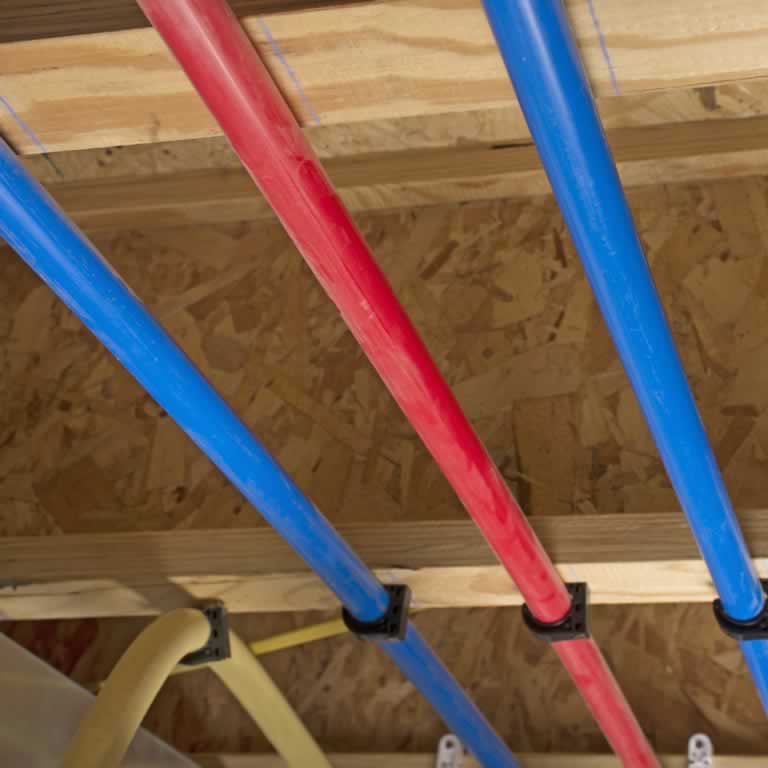Poly B pipe replacement can feel like a daunting task, but you've come to the right place to make it a smooth and successful journey. We know you're already aware of the issues with Poly B pipes and why they need to be replaced, so we won't bore you with those details.
Instead, we'll dive straight into the practical aspects of this process.
In this post, we'll explore the different materials available for replacing your Poly B pipes, discuss the pros and cons of DIY vs. hiring a professional plumber, break down the factors that influence costs, and walk you through the three stages of pipe replacement: preparation, replacement, and post-replacement.
By the end, you'll be armed with the knowledge you need to make informed decisions and ensure a successful pipe replacement experience.
So, let's get started! 😊
Table of Contents
Types of Pipes
When it comes to plumbing, the materials you choose can make a world of difference in durability, cost, and ease of installation. In the realm of Poly B pipe replacement, three materials tend to take the spotlight: PEX, Copper, and PVC/CPVC.
Let's take a closer look at how these materials stack up against each other.
| Material | Pros | Cons |
|---|---|---|
| PEX (Cross-linked Polyethylene) |
|
|
| Copper |
|
|
| PVC/CPVC (Polyvinyl Chloride/Chlorinated Polyvinyl Chloride) |
|
|
It's worth noting that when we talk about PEX, there are actually three different types: PEX-A, PEX-B, and PEX-C. These subtypes differ in the method of production and slightly in their characteristics:
- PEX-A: Known for its flexibility, PEX-A is the most adaptable of the three types, making it a favorite for intricate plumbing systems. It can withstand a fair amount of twisting and turning without losing its structural integrity.
- PEX-B: This type is slightly less flexible than PEX-A but tends to be more resistant to chemical damage. It's a reliable option for both hot and cold water supply lines.
- PEX-C: Though less common, PEX-C is appreciated for its high-temperature resistance. However, it's not as flexible as PEX-A or PEX-B, which can make it a bit more challenging to install.
Each type of PEX has its unique advantages, and your choice between them will depend on your specific needs and circumstances.
It's always a good idea to discuss these options with a plumbing professional to make sure you're making the best choice for your home.
Now that you have a basic understanding of each material, let's dig a bit deeper into choosing the right one for your home.
The choice between PEX, Copper, and PVC/CPVC will largely depend on your specific circumstances, such as your budget 💰, local building codes, and even your local climate.
For instance, if you live in an area with a lot of sun ☀️ exposure, copper might be a better choice due to its sunlight tolerance.
On the other hand, if you're looking for a good balance of affordability and durability PEX would be more suitable (it's actually the most popular choice).

Remember, while cost and ease of installation are important considerations, it's also crucial to consider long-term durability and maintenance. You might save money upfront with a cheaper material like PVC/CPVC, but if it needs to be replaced again in a few years, the costs could add up. The goal of replacing your Poly B pipes is to ensure a long-lasting, trouble-free plumbing system, so it's worth investing in a material that can stand the test of time.
DIY vs. Going Pro: Making the Choice
We live in a world where we can learn to do just about anything from the internet. From baking a fancy cake 🎂 to building 🧰 a deck, there's a YouTube video, online course, or how-to guide for it. And yes, even for Poly B pipe replacement. But just because you can, does it mean you should?
We applaud the DIY spirit, we really do. There's a certain satisfaction in rolling up your sleeves and tackling a project head-on. But when it comes to plumbing, and more specifically replacing Poly B pipes, the stakes are high. This isn't like putting together a piece of flat-pack furniture – if something goes wrong, it can lead to serious damage and cost you more in the long run.
Here's the thing: replacing Poly B pipes is a complex process. It requires knowledge of local building codes, expertise in various plumbing techniques, and a deep understanding of your home's plumbing system. This is where professional plumbers shine. They have the training, experience, and tools necessary to get the job done right the first time.
So, while you may have seen a video or two of someone handling their own pipe replacement, we strongly recommend leaving this one to the professionals.
A reputable plumber will ensure that your new pipes are installed correctly and safely, giving you peace of mind.
Finding a plumber isn't as daunting as it may seem. Start by asking friends and family for recommendations, and then do your own research online. Look for licensed plumbers with good reviews and transparent pricing. Don't be afraid to ask questions – a good plumber will be happy to put your mind at ease and explain their process.
Remember, investing in professional pipe replacement now can save you a lot of stress, time, and money down the line. Sometimes, the best DIY project is knowing when to call in the pros.
Understanding Costs
As with any home improvement project, it's important to understand the costs involved in Poly B pipe replacement. This is not a one-size-fits-all kind of expense – there are several factors that can influence how much you'll end up paying. Understanding these factors can help you budget appropriately and avoid any unpleasant financial surprises.

Here are some of the key factors that can impact the cost of your pipe replacement:
- Type of material: As we discussed earlier, the type of material you choose for your new pipes can significantly impact the cost. Copper tends to be more expensive than PEX or PVC/CPVC, for instance.
- Size of your home: The larger your home, the more piping you'll need, which can increase the cost of both materials and labor.
- Complexity of your plumbing system: If your plumbing system is complex or difficult to access, it may take longer to complete the replacement, which can increase labor costs.
- Local labor rates: Labor costs can vary widely depending on where you live. Areas with a higher cost of living typically have higher labor rates.
- Any necessary repairs or modifications: If any additional repairs or modifications to your home's structure are needed to complete the replacement, this can also add to the cost.
- Choice of plumbing contractor: The experience and approach of your chosen plumber can significantly impact the cost. A more experienced plumber might charge more, but they could also work more efficiently and effectively, possibly saving you money in the long run. Similarly, a plumber who takes a comprehensive approach — considering your home's overall plumbing system and future needs — might offer more value than one who simply replaces the pipes.
Given these variables, it's tough to provide a one-size-fits-all estimate for a Poly B pipe replacement. However, it's always a good idea to get quotes from several plumbers to ensure you're getting a fair price. Don't be afraid to ask for an itemized quote so you can see exactly where your money is going.
Remember, while cost is certainly an important factor, it shouldn't be the only one. The quality of the work is equally, if not more, important. A properly done replacement will save you from potential headaches and additional costs down the line.
The Poly B Replacement Journey
Embarking on a Poly B pipe replacement project is a bit like setting off on a journey. Knowing what to expect at each stage can help you navigate the process with confidence and ease. 👍😊
From preparation to replacement, and, finally, to post-replacement, each step plays a crucial role in ensuring a successful transition from your old pipes to your new ones. Let's unpack these stages to give you a clearer roadmap of what lies ahead.
Preparation
This is your planning stage, where you'll make key decisions that set the course for your project. You'll choose your plumber, select your pipe material, and schedule the work.
Remember, pipe replacement is not a quick process; it can cause some disruption to your normal routine, especially when it comes to water usage. It's important to plan for this disruption and make necessary arrangements to minimize any inconvenience.
Replacement
Now, we're in the heart of the action. Your selected plumber will remove the old Poly B pipes and install your new ones. While you might not understand every technical detail, rest assured your plumber is working with a clear plan and professional expertise to install your new pipes correctly.
Post-Replacement
Once the work is complete, there's a period of adjustment. You'll need to keep an eye out for any potential issues, such as leaks or changes in water pressure. It's perfectly normal to encounter some minor hiccups after a replacement – this doesn't mean the job was done poorly.
It's simply part of the process, and your plumber should be available to address any concerns.
Understanding these stages helps you prepare for the journey ahead, giving you peace of mind as you upgrade your home's plumbing system. With a clear roadmap in hand, you're ready to set off on your Poly B pipe replacement journey!
Wrap-Up: Your Replacement Recap
And there you have it – your comprehensive guide to navigating a Poly B pipe replacement. You're now well-equipped with the knowledge of the materials to consider, the importance of choosing a professional plumber over going the DIY route, the various cost factors, and what to expect throughout the three stages of the process.
Remember, replacing Poly B pipes is more than just a home improvement task; it's an investment in your home's future and your peace of mind. By making informed decisions, you're ensuring the health and longevity of your plumbing system.
Don't be shy about reaching out to professionals and asking questions. Knowledge is power, especially when it comes to home maintenance. A reputable plumber will welcome your curiosity and be ready to provide you with all the information you need.
Remember that every journey begins with a single step. In this case, that step is deciding to replace those old Poly B pipes. From there, it's about taking one stage at a time, and before you know it, you'll have successfully navigated this home improvement adventure.
Thanks for joining us on this journey. Here's to smooth plumbing and peace of mind!
